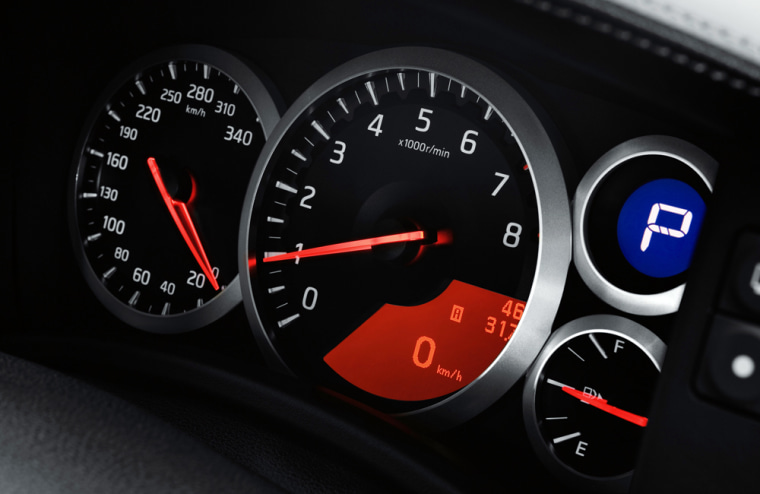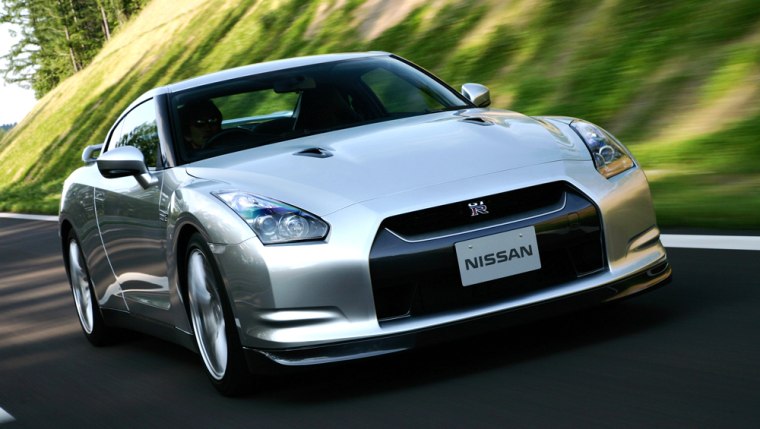It was always the button that activated the saw blade on Speed Racer’s Mach 5 that I liked. Forget the overused “jump over the bad guy’s car” button. Who needs that when you have the “cut the bad guy’s car in half” button?
Clearly Nissan’s engineers were influenced by the old Japanese TV show (and now movie) in building the GT-R, arguably the most eagerly awaited new vehicle of the 2009 model year.
The 2009 GT-R is set to debut in the United States next month, and while there’s no button for a saw or one that will launch the car into the air, there are buttons to adjust the shocks and stability control and displays for steering position and performance data.
The GT-R is the first such model sold in the U.S., but the car, which has been around for 40 years, has a fanatical following among young American drivers because of its incredible performance in the popular Gran Turismo video game.
To cement the connection between game and road, virtual reality and reality, Nissan designers added an interface that lets GT-R drivers electronically adjust various settings and review performance parameters on the dashboard. The system was designed in conjunction with programmers who work on the Gran Turismo game to ensure maximum familiarity to gamers who have presumably now grown up and found jobs.
A row of three toggle switches across the middle of the dash center stack each provides three different settings for the transmission’s shift program, the stiffness of the electronically adjustable shock absorbers and the leeway permitted by the electronic stability control system before it intervenes to maintain control of the car.
Above that, at the top of the dash, the multifunction display exhibits 17 different performance parameters, giving drivers the ability to see data to back up their bragging, with the computer confirming the number of lateral G's of cornering force or displaying the steering angle and throttle position.

All of this is pretty difficult to review in real time while driving, so the driver can plug in a memory card to download data from the car and review it on a computer in spreadsheet form.
With this heavy emphasis on electronics, data, specs and gadgets, it might be easy to forget that the GT-R is a car, with real attributes when driven in the real world. As promised, the car is docile and friendly at parking lot speeds, with no stiff clutch pedal to wear out the driver’s left leg.
Under way, the 3.8-liter twin-turbo-V6 engine pulls forcefully, with a character that is most similar in delivery to that of the Porsche 911 Turbo. Also like the Porsche, the wide front tires tend to tramline, following pavement seams and imperfections, so the tires tug at the steering wheel and cause the car to wander a bit at low-to-medium speeds.
Unlike the 911, however, this tendency diminishes with speed, so the GT-R conveys confidence-inspiring stability at high speeds, while the 911 hunts around in the lane in a way that erodes confidence that the car is doing exactly what the driver wants.
All-wheel-drive systems recently have become much more sophisticated, actively channeling power as needed to prevent intrusion on the car’s handling characteristics. This lets the four-wheel-drive GT-R handle more like a race car than a 4x4, which is a marked improvement over earlier AWD supercars such as the Lamborghini Murcielago. That car suffered distinct understeer on corner turn-in because of the power coursing through the front tires, but the GT-R dials most of the power to the rear under those circumstances, leaving the front tires free to steer more precisely.
The GT-R’s monstrous brakes are supplied by the fashionable Italian house of Brembo and, for those comparing specs at home, feature six pistons in the radial-mounted front calipers and four pistons in the rears, with 15-inch full-floating rotors front and back. Those are the specs, but the real-world experience is of brakes that exhibit a nice touch in around-town driving, without grabbing.
At racetrack speeds, when street cars routinely roast their brakes, the GT-R withstood hours of use while providing excellent stopping distances and a firm, fade-free pedal. There were wisps of smoke from cars entering the pit lane and the smell of burned brakes, but beyond these superficial symptoms, the brakes held up fine.
It will be tough to argue logically that there are many better high-performance cars than the GT-R. Its 480 horsepower twin-turbo V6 engine and paddle-shifted dual-clutch manual transmission channel the power through all four wheels to produce a manufacturer-estimated 0-60 acceleration time of 3.5 seconds. That makes the GT-R quicker off the line than any new car but the uber-expensive and finicky Murcielago, leaving behind would-be rivals such as the Porsche 911 Turbo, Lamborghini Gallardo, Ferrari F430, Dodge Viper and Corvette Z06.
And unlike some of those cars the GT-R can click off one run after another at that pace with an average driver at the wheel because the computer-controlled transmission and advanced all-wheel-drive systems apply the force of internal combustion with the mathematical precision of TurboTax (and about the same level of excitement).
But the GT-R distinctly misses in few couple areas. The Nissan’s superb V6 delivers immense power and has a sound that is agreeable but subdued for a supercar. It surely falls short of a unique aural signature or a mechanically produced call to battle. Cars like the Corvette and the F430 seem worth the price of admission just for their intoxicating exhaust notes.
The cabin is adequately but not opulently outfitted, which is surely a tradeoff most enthusiast drivers are willing to make, even in a $70,000 car, in exchange for the GT-R’s otherworldly performance. But they might not be able to enjoy that performance for very long because of the distinctly cheap and uncomfortable bucket seats, which lack adjustment for lumbar support.
The front seats are at least better than the rear seats, which border on useless. Here again, the GT-R is similar to the 911, with its for-display-purposes-only rear seats. While some coupes have snug rear buckets that are difficult to clamber into and out of, but which are tolerable once the occupants are in place, the GT-R’s rear seats are purely decorative for adults, with some occupants’ heads touching the rear window glass.
Utility is not the reason people buy cars like the GT-R, though by measures such as the ability to drive the car in foul weather, the GT-R can even stake a claim to utility even if the back seat is pointless.
Some customers buy performance cars for their charisma, sound and visceral experience as much for the times they can put on a stopwatch, and for those customers the GT-R will be an aesthetic disappointment. But for those who worship results above all, and who crave the opportunity to pore over computer data from the car and match specs with online rivals, the GT-R is a dream come true.
Unless, that is, you dream of built-in saw blades.
